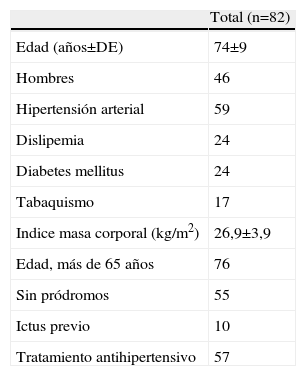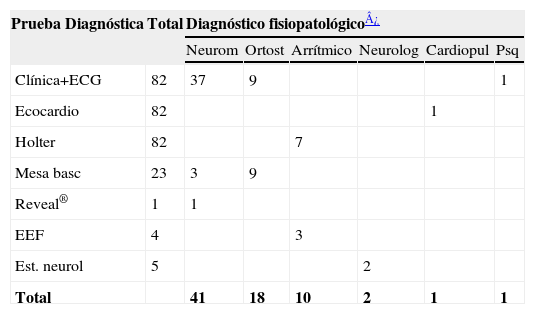El síncope de alto riesgo (más de 65 años, electrocardiograma anormal, síncope sin pródromos y/o antecedentes de patología cardiovascular) se asocia a una elevada mortalidad. Parece aconsejable una atención más detallada de la que puede ofrecerse en Urgencias. Hemos evaluado la actividad de una consulta monográfica de síncope en un Servicio de Cardiología.
Material y métodosHemos recogido una serie de enfermos diagnosticados en Urgencias de «sincope». Los enfermos fueron remitidos a la consulta monográfica de síncope y evaluados en menos de 72h. Hemos analizado las pruebas realizadas para establecer un diagnóstico fisiopatológico del síncope.
ResultadosEstudiamos 107 pacientes consecutivos, de los que 82 cumplían criterios de síncope de riesgo. A todos se les realizó una ecocardiografía y un Holter ambulatorio. Se realizaron 23 estudios con mesa basculante, 4 estudios electrofisiológicos, y se implantaron 2 Holter insertables. En 73 pacientes pudimos establecer un diagnóstico concreto. Tres pacientes fueron diagnosticados de una enfermedad neurológica. La causa más frecuente del síncope fue la neuromediada (41 pacientes). Tras un seguimiento medio superior a 2 años, la mortalidad total (9 pacientes) no se relacionó con el síncope.
ConclusionesUna consulta especializada en síncope de alto riesgo aumenta el porcentaje de pacientes con diagnóstico definitivo.
High-risk syncope (over aged 60, abnormal electrocardiogram, syncope without prodromes and/or background of cardiovascular disease) is associated with high mortality. More detailed attention to that which may often be considered as an emergency should be given. We have evaluated the activity of a specialized service in the care of syncope in an internal medicine service.
Material and methodsWe have collected a series of patients diagnosed in the emergency service of “syncope.” The patients were referred to the specialized unit in the care of syncope and evaluated in less than 72h. We analyzed the tests made to establish a pathophysiological diagnosis of syncope.
ResultsA total of 107 consecutive patients were studied, 82 of whom met the criteria for being at risk of syncope. All underwent an echocardiography and outpatient Holter. A total of 23 studies were performed with tilt test, 4 electrophysiological studies were performed and 2 were implanted with an insertable Holter. A specific diagnosis could be established in 73 patients. Three patients were diagnosed with a neurological disease. The most frequent cause of the syncope was neuromediated (41 patients). After a mean follow-up of over 2 years, total mortality (9 patients) was not related with the syncope.
ConclusionsA specialized service in the care of high-risk syncope increases the percentage of patients with a definitive diagnosis.
Artículo
Diríjase desde aquí a la web de la >>>FESEMI<<< e inicie sesión mediante el formulario que se encuentra en la barra superior, pulsando sobre el candado.

Una vez autentificado, en la misma web de FESEMI, en el menú superior, elija la opción deseada.

>>>FESEMI<<<









